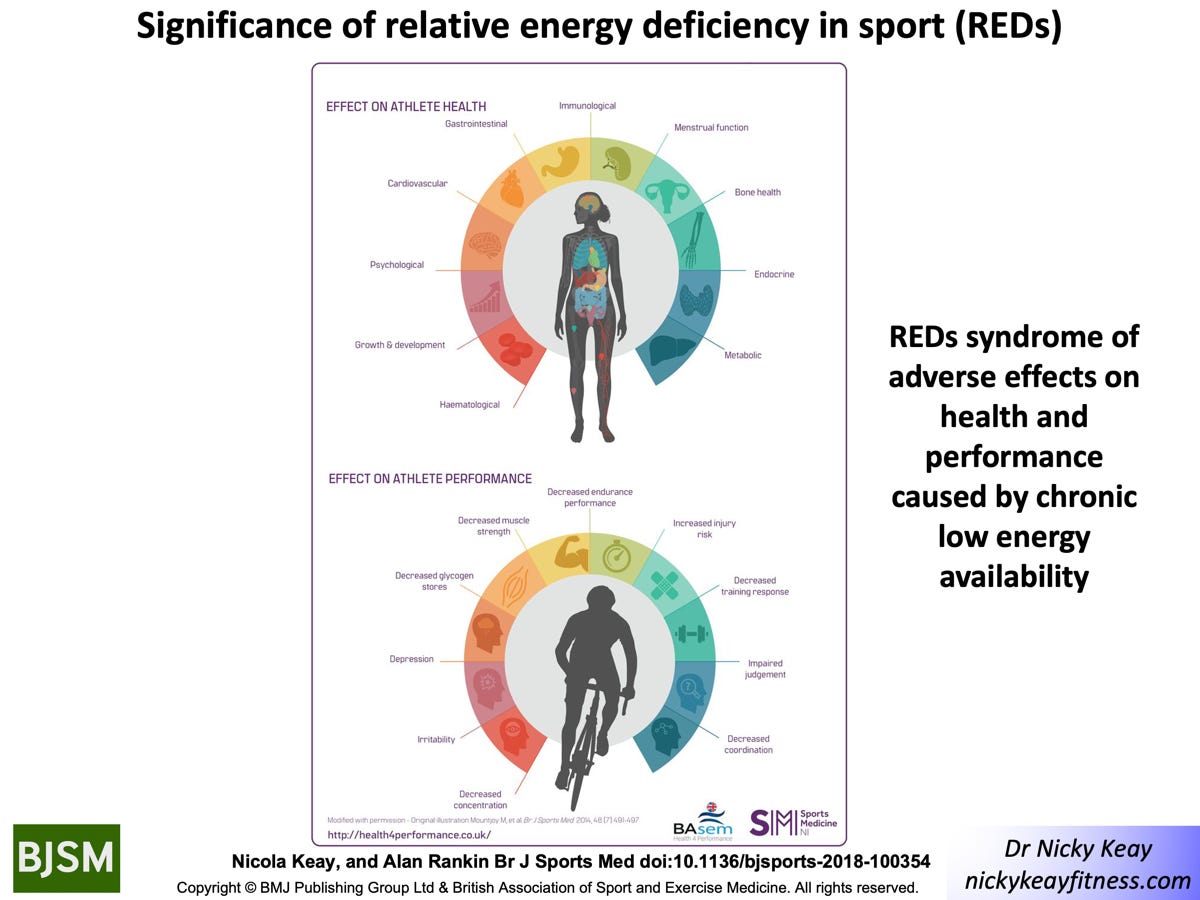What is REDs?
Relative energy deficiency in sport is a condition of low energy availability. In female athletes, the menstrual cycle can be affected. Dr Nicky Keay, a Sports and Dance Endocrinologist, explains more
Relative energy deficiency in sport (REDs) describes the syndrome, a collection of symptoms and signs of adverse health and performance due to long-term energy deficit.
REDs was first described in the International Olympic Committee (IOC) consensus statement 2014 and there have been two updates in 2018 and 2023.
Energy deficit arises where energy intake is not sufficient to meet total energy demands.
Energy demands include that of exercise training and energy to maintain fundamental physiological processes.
Low energy availability is the term used to describe the situation where, once the energy demand from exercise has been met, there is a shortfall in the energy available to maintain healthy physiological function for the individual.
Low energy availability can arise unintentionally where the athlete underestimates the total amount of energy required.
The body will prioritise the energy demand for movement, but the residual energy is insufficient to meet other body demands.
On the other hand, an athlete can intentionally end up in low energy availability by consciously restricting energy intake in the belief that this will confer a performance or an aesthetic advantage.
The body adapts to low energy availability by going onto “energy saving mode”. Just as a mobile phone on low power goes into energy saving mode.
This includes putting many of the hormone networks in the body on “go slow”. The problem is that hormones are essential for maintaining optimal health and supporting athletic performance.
One the primary indicators of REDs for female athletes is that the menstrual cycle stops. The equivalent in men is lower production of testosterone.
The consequence of low hormone levels is increased risk of injury. In particular bone stress injuries, which are another primary indicator of REDs.
For the younger athlete, slowing of growth and development can indicate REDs.
The athlete may generally feel fatigued with poor recovery and poor sleep. The athlete may be restricting food intake and/or have a very high training load.
As REDs is caused by low energy availability, the primary objective is to support the athlete in restoring energy balance.
In practical terms this means increasing and maintaining energy intake. In particular hormones are very sensitive to a consistent intake of complex carbohydrate (eg cereals, bananas, bread, pasta, rice) over the day.
This will be in conjunction with reducing energy demand by dialling down the intensity of training temporarily.
For female athletes whose periods have stopped due to REDs and there is evidence of poor bone health (from bone stress injuries and/or DXA scan) then temporising bone protection with hormone replacement therapy (HRT) may be necessary. (The combined contraceptive pill is not bone protective.)
What can clubs and coaches do?
Coaches be really helpful in helping prevent REDs in their athletes by encouraging positive behaviours around fuelling for training and ensuring than an individual is not over training for their age.
If a coach notices that an athlete is withdrawing from the group, looking fatigued or underperforming, then it can be helpful to check in with the athlete than nothing is amiss. Depending on the age of the athlete, with the permission of the parents.
Clubs and teams can raise awareness of REDs with information posters and/or information on their website.
Based on research we have developed a free, web-based app for athletes called PEAQ (personal energy availability questionnaire).
It takes athletes through a short questionnaire and instantaneously generates a personal report. Access the app here.
A club can also host talks to teams to help raise awareness. As a medical doctor with clinical and research experience in REDs I offer talks (in person or virtual) to clubs and teams
More information about Nicky:
Nicky offers personal advisory appointments to athletes of all ages and levels.
For further information about REDs check out the chapter in Nicky’s book: “Hormones, Health and Human Potential”
Did you know there’s a subscription option for Coaching Care Creativity? Nothing is behind a paywall so your subscriptions or coffee clicks can help keep the content going. The subscriptions are £5 a month or £50 for the year. You can also buy me a one-off coffee for just £5.





Wrote on that about pro tennis players a few years ago and was stunned at the consequences and at the frequency of the issue...